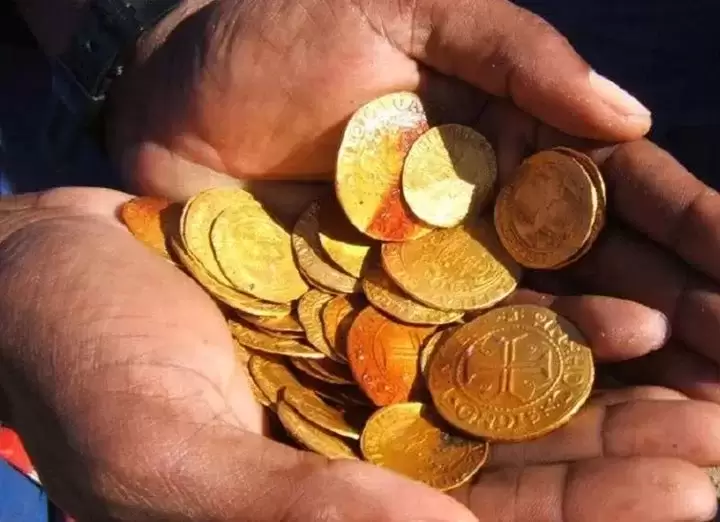 |
|
 |
|
 |
|
 |
|
 |
|
 |
|
 |
|
 |
|
 |
|
 |
|
 |
|
 |
|
 |
|
 |
|
 |
|
1533 년에 잃어버린 포르투갈 선박은 나미비아 사막에서 재 포장되어 동전, 잉곳, 세계 무역 역사를 엿볼 수있는 보물을 제공합니다. Kele Johnson.

A Portuguese vessel lost in 1533 has recently resurfaced in Namibia’s desert, offering a treasure trove of coins, ingots, and a glimpse into global trade history.
1533 년에 잃어버린 포르투갈 선박은 최근 나미비아 사막에서 재 포장되어 동전, 잉곳, 세계 무역 역사를 엿볼 수있는 보물을 제공합니다.
Miners searching for diamonds in one of the most unlikely places on earth—the blazing sands of the Namib Desert—uncovered a time capsule from the Age of Discovery. They were working on a new section of the diamond mine in 2008 when they unearthed the remains of the Bom Jesus (which translates to “The Good Jesus”), a Portuguese trading vessel lost at sea nearly 500 years ago. The final voyage had ended, but not in the waters off the coast of Africa. It had ended inland, where the desert meets the Atlantic coast.
지구상에서 가장 가능성이없는 곳 중 하나 인 Namib 사막의 타오르는 모래 중 하나에서 다이아몬드를 찾는 광부들은 발견 시대부터 타임 캡슐을 흡수했습니다. 그들은 거의 500 년 전 바다에서 잃어버린 포르투갈 거래 선박 인 Bom Jesus (“선한 예수”로 번역)의 유골을 발굴했을 때 2008 년에 다이아몬드 광산의 새로운 섹션에서 일하고있었습니다. 마지막 항해는 끝났지 만 아프리카 해안의 해역에서는 끝나지 않았습니다. 사막이 대서양 연안을 만나는 내륙이 끝났습니다.
And it was filled with treasure.
그리고 그것은 보물로 가득 차있었습니다.
The Bom Jesus was a Portuguese nau (also called a Carrack) that departed Lisbon on Friday, March 7, 1533, captained by Sir Francico de Noronha, bound for the lucrative trade routes of the East. The ship’s fate remained a mystery for centuries—until 2008, when diamond miners discovered its wreck near Oranjemund on Namibia’s Atlantic coast. Its discovery marked a milestone in maritime archaeology: the Bom Jesus is now considered the oldest and most significant shipwreck found along the western edge of Sub-Saharan Africa.
Bom Jesus는 1533 년 3 월 7 일 금요일에 리스본을 떠난 포르투갈어 나우 (Carrack이라고도 함)였으며, Francico de Noronha 경은 동방의 유리한 무역 경로를 위해 경계를 맡았습니다. 이 배의 운명은 다이아몬드 광부가 나미비아 대서양 해안에서 오란 곤드 근처에서 난파선을 발견 한 2008 년까지 수세기 동안 미스터리로 남아있었습니다. 그 발견은 해상 고고학에서 이정표가되었습니다. Bom Jesus는 이제 사하라 이남 아프리카의 서쪽 가장자리를 따라 발견 된 가장 오래되고 가장 중요한 난파선으로 간주됩니다.
Built in the early 16th century during Portugal’s golden age of exploration, the Bom Jesus likely belonged to a new generation of ships designed to endure the long and perilous voyages between Europe and Asia. These naus were built larger and sturdier than earlier vessels, being built to withstand the treacherous passage around the Cape of Good Hope and back.
포르투갈의 황금 시대의 황금 시대에 16 세기 초에 지어진 BOM 예수는 아마도 유럽과 아시아 사이의 길고 위험한 항해를 견뎌 낼 수 있도록 설계된 새로운 세대의 배에 속했을 것입니다. 이 구역은 이전의 선박보다 더 크고 견고하게 지어졌으며, 좋은 희망과 뒤의 망토 주변의 위험한 통로를 견딜 수 있도록 만들어졌습니다.
The hull of the Bom Jesus was constructed using advanced shipbuilding techniques for the time. It was a vessel of considerable size and draft, a testament to the Portuguese prowess in shipbuilding during the Age of Discovery.
Bom 예수의 선체는 당분간 고급 조선 기술을 사용하여 구성되었습니다. 그것은 상당한 크기와 초안의 선박이었다.
Although little documentation of the ship survives, experts believe the Bom Jesus was headed for the Indian subcontinent, carrying a cargo tailored for trade.
선박에 대한 문서가 거의 살아남지 못했지만 전문가들은 BOM 예수가 인도 아대륙으로 향하고 있으며 무역을 위해 맞춤화 된화물을 들고 있다고 믿고 있습니다.
The archaeologists called to the site uncovered an staggering hoard. Approximately 2,000 gold coins were recovered from the site, predominantly Spanish excellentes featuring the likenesses of Isabella I of Castile and Ferdinand II of Aragon. Portuguese coinage was also present, including cruzados from the reigns of Kings Manuel I and João III. Additionally, coins from Venice, France, and various Muslim states were found, indicative of the extensive trade connections of the period. The inscriptions and designs on these coins were instrumental in dating the shipwreck to the early 1530s.
고고학자들은이 사이트에 전화를 걸었습니다. 약 2,000 개의 금화가 현장에서 회수되었으며, 주로 스페인의 우수는 Castile의 Isabella I와 Aragon의 Ferdinand II의 모습을 특징으로합니다. Kings Manuel I와 João III의 통치의 Cruzados를 포함하여 포르투갈 주화도 존재했습니다. 또한 베니스, 프랑스 및 다양한 무슬림 국가의 동전이 발견되었으며,이 기간의 광범위한 무역 연결을 나타냅니다. 이 동전의 비문과 디자인은 1530 년대 초반 난파선과 데이트하는 데 중요한 역할을했습니다.
Another surprise came in bulk. The find included 1,845 copper ingots, each stamped with a trident mark linking them to the powerful Fugger banking family of Germany, which were found amidst the wreckage. These ingots, weighing some 17 tons, had originally been shipped from Central Europe and were headed for India, where copper was a prized trade commodity. The Fuggers’ mark made this historical find even richer, providing substantial proof of copper’s role in global commerce and the Fugger family’s significant role in supplying copper for trade during the Renaissance.
또 다른 놀라움은 대량으로 나왔습니다. 이 발견에는 1,845 개의 구리 잉곳이 포함되었으며, 각각은 탁월한 마크가 포함되어 있으며 독일의 강력한 Fugger Banking 가족과 연결되어 있으며, 이는 잔해 속에서 발견되었습니다. 무게가 약 17 톤 인이 잉그는 원래 중부 유럽에서 선적되었으며 구리가 소중한 무역 상품 인 인도로 향했습니다. Fuggers의 마크는이 역사적 으로이 역사적으로 더욱 풍부하게 만들어서 글로벌 상거래에서 구리의 역할에 대한 실질적인 증거와 르네상스 동안 무역을위한 구리 공급에있어서 Fugger 가족의 중요한 역할을 제공했습니다.
The preservation was extraordinary. While only a small part of the wreck’s original structure was preserved, the ship’s contents were found in relatively good condition. Namibia’s dry climate and the heavy copper cargo helped create a sealed environment, protecting not just the metal but also elephant tusks, navigational instruments, weapons (including a 500-year-old musket and cannons), and personal effects—all eerily well-preserved.
보존은 특별했습니다. 난파선의 원래 구조의 작은 부분 만 보존되었지만 선박의 내용물은 비교적 양호한 상태로 발견되었습니다. 나미비아의 건조한 기후와 무거운 구리화물은 밀봉 된 환경을 조성하여 금속뿐만 아니라 코끼리 엄니, 항해 기기, 무기 (500 년 된 소총과 대포 포함), 개인 효과를 보호하는 데 도움이되었습니다.
Dr. Dieter Noli, the lead archaeologist at the South African Institute for Maritime Archaeological Research, maintains that the copper ingots were responsible for the remarkable preservation of the ship’s cargo. “Marine organisms may like wood, book covers, peach pits, jute sacks, and leather shoes, but copper really repels them from their food – so a lot of things survived 500 years at the bottom of the sea that really shouldn’t have.”
남아프리카 해양 고고학 연구소의 고고학자 인 Dieter Noli 박사는 구리 잉곳이 선박의화물의 놀라운 보존에 책임이 있다고 주장합니다. "해양 유기체는 나무, 책 표지, 복숭아 구덩이, 황마 자루 및 가죽 신발을 좋아할 수도 있지만 구리는 실제로 음식에서 그들을 격퇴합니다. 그래서 많은 것들이 바다의 바닥에서 500 년 동안 살아 남았습니다."
The find is the stuff of legend for treasure hunters and history buffs. For numismatists, it’s a windfall of study materials and historical significance.
그 발견은 보물 사냥꾼과 역사 애호가들을위한 전설의 것들입니다. 화폐 학자들에게는 연구 자료와 역사적 중요성의 횡재입니다.
Seventeen years after its discovery, the exact fate of the Bom Jesus and how it came to rest in Namibia is still uncertain. The prevailing theory is that a violent storm pushed the ship toward the coast, where it ran aground.
발견 된 지 17 년 후, Bom Jesus의 정확한 운명과 나미비아에서 어떻게 쉬게되었는지는 여전히 불확실합니다. 우세한 이론은 폭력적인 폭풍이 배를 해안으로 밀고 그곳에서 쫓겨났다는 것입니다.
Though many items remain in conservation, plans are to exhibit the Bom Jesus artifacts to the public eventually. In the meantime, the find continues to offer new clues about a time when ships like the Bom Jesus helped stitch together a truly global economy.
많은 항목이 보존 상태에 있지만, 결국 Bom Jesus Artifacts를 대중에게 전시 할 계획입니다. 그 동안이 발견은 예수와 같은 배가 진정한 세계 경제를 꿰매는 데 도움을 주었던시기에 대한 새로운 단서를 계속 제공합니다.
부인 성명:info@kdj.com
제공된 정보는 거래 조언이 아닙니다. kdj.com은 이 기사에 제공된 정보를 기반으로 이루어진 투자에 대해 어떠한 책임도 지지 않습니다. 암호화폐는 변동성이 매우 높으므로 철저한 조사 후 신중하게 투자하는 것이 좋습니다!
본 웹사이트에 사용된 내용이 귀하의 저작권을 침해한다고 판단되는 경우, 즉시 당사(info@kdj.com)로 연락주시면 즉시 삭제하도록 하겠습니다.





























































